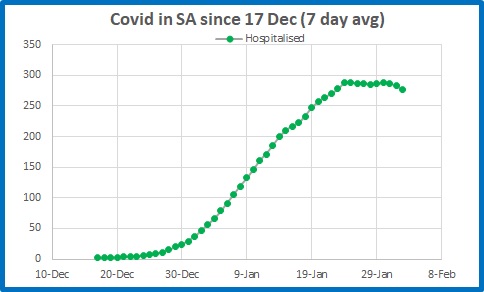In this post I am looking at the pandemic experience across New South Wales, Victoria, Queensland, and South Australia, since the Queensland border was opened on 17 December 2021. Tasmania, the Northern Territory, and the ACT are excluded because their numbers so far are too low for useful analysis, and WA of course is still a hermit kingdom.
I use data from the excellent site, Covid-19 in Australia.
That site has excellent comparative charts, however I wanted to pick up on some points which are not so clear.
For some time Chief Health Officers have been warning that case numbers are a poor metric of Covid infections. Here’s why:
Figures 1 to 4 show 7 day running means of reported daily positive cases of Covid-19 for each state.
Figure 1: Queensland cases
Figure 2: New South Wales cases
Figure 3: Victorian cases
Figure 4: South Australian cases
Notice that the high point for all states was reached at about the same date, and cases in all states plummeted after the 20th January. (Victoria plummeted from the 15th.) All states gave up trying to keep up with the testing demand and Rapid Antigen Tests were as rare as hens’ teeth.
Case numbers we can then ignore: they may be two, three, or more times higher.
A better metric will be the seven day rolling mean number of people in hospital, in Intensive Care, or dying.
Figure 5: Queensland daily numbers in hospital
Hospitalisations peaked on Australia Day and are slowly falling.
Figure 6: NSW daily numbers in hospital
In NSW there was no distinct peak but hospitalisations have been gradually falling since 25 January.
Figure 7: Victoria daily numbers in hospital
Victoria’s peak was on 21 January.
Figure 8: South Australia daily numbers in hospital
South Australian hospitalisations stopped rising on 25 January with a slow fall since.
Figure 9: Queensland daily ICU and mortality numbers
Although Qld hospitalisations have declined, ICU numbers have remained at about 50 for two weeks. Deaths are also plateauing.
Figure 10: NSW daily ICU and mortality numbers
Despite a fall in the number of ICU patients, deaths are high, and it is still too early to see a peak.
Figure 11: Victoria daily ICU and mortality numbers
There is a similar situation in Victoria. While ICU numbers have fallen, deaths have plateaued over the last six days.
Figure 12: South Australia daily ICU and mortality numbers
Only in South Australia do we see a distinct fall in deaths, with a corresponding fall in ICU numbers. Let’s hope this continues. However, it is possible there is something different about the data reporting.
Across these states there appears to be a delay of from 7 to 10 days from the suspected peak in case numbers to hospital admission, and 14 to 16 days from peak in cases to death.
Of those admitted to hospital, the chance of going into ICU is:
Queensland: 1 in 17
NSW: 1 in 15
Victoria: 1 in 9
Sth Australia: 1 in 5 – 6
Once in ICU, the chance of dying is:
Queensland: 1 in 4 -5
NSW: 1 in 6
Victoria: 1 in 5
Sth Australia: 1 in 8
In Queensland, based on official case numbers, an individual testing positive (all ages and all vaccination states) has a 1 in 20 chance of being sick enough to go to hospital; 1 in 345 of being admitted to ICU; and 1 in 1,500 of dying. (For healthy, fit individuals under the age of 60 the chances will be considerably smaller.)
Conclusion 1: In these four states, we are almost over the worst, and the health systems have managed to cope (albeit with leave being cancelled and great stress on staff).
Conclusion 2: Covid-19 loves people to live in big cities, or to live in crowded conditions, or to have lowered immunity and chronic health conditions, or to be elderly. Nursing homes fit those last three conditions nicely. Many nursing home inmates also have Advanced Health Directives, many probably stipulating they do not wish to have resuscitation or ventilation. A high death toll in nursing homes is to be expected with a highly transmissible and nasty flu like Covid.











